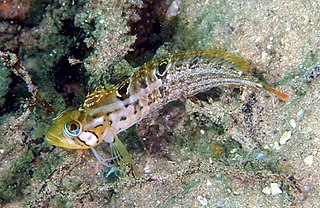
Isopoda is an order of crustaceans that includes woodlice and their relatives. Isopods live in the sea, in fresh water, or on land. All have rigid, segmented exoskeletons, two pairs of antennae, seven pairs of jointed limbs on the thorax, and five pairs of branching appendages on the abdomen that are used in respiration. Females brood their young in a pouch under their thorax.

The hunchback amphipod, Iphimedia gibba, is a species of amphipod crustacean. It is a marine arthropod in the family Iphimediidae.

Triviella ovulata, common name "baby's toes", is a species of small sea snail, a marine gastropod mollusc in the family Triviidae, the trivias.

The iridescent nudibranch, Notobryon sp, is an undescribed species of scyllid nudibranch, and is found in South Africa. It is a marine gastropod mollusc in the family Scyllaeidae.

Pecten sulcicostatus, the South African scallop, is a species of large scallops or saltwater clams. They are marine bivalve molluscs in the family Pectinidae, the scallops.

Venus verrucosa, the warty venus, is a species of saltwater clam. It is a species of marine bivalve mollusc in the family Veneridae, sometimes collectively known as the venus clams.

Bullia digitalis, the finger plough shell or plough snail, is a species of sea snail, a marine gastropod mollusk in the family Nassariidae, the Nassa mud snails or dog whelks.

Calliostoma ornatum, common name the ornate topshell, is a species of sea snail, a marine gastropod mollusk in the family Calliostomatidae.

Clinus venustris, the speckled klipfish, is a species of clinid that occurs in subtropical waters of the Atlantic Ocean from Namibia to South Africa where it is found in the subtidal zone as well as being a denizen of tide pools. This species can reach a maximum length of 12 centimetres (4.7 in) TL. and feeds primarily on amphipods, isopods, mysids, and echinoderms.

Callopatiria granifera, the red starfish, is a southern African species of starfish in the family Asterinidae.

Ligia diletata is a woodlouse in the family Ligiidae.
Chiton salihafui, the python chiton, is a medium-sized polyplacophoran mollusc in the family Chitonidae, found on the west coast of Africa.

Chiton politus, the tulip chiton, is a medium-sized polyplacophoran mollusc in the family Chitonidae, found on the coast of southern Africa.

Callochiton dentatus, the broad chiton, is a medium to large-sized polyplacophoran mollusc in the family Callochitonidae, found on the coast of southern Africa.

Acanthochitona garnoti, the spiny chiton, is a medium-sized polyplacophoran mollusc in the family Acanthochitonidae, found on the coast of southern Africa.

Onithochiton literatus, the black chiton, is a medium to large-sized polyplacophoran mollusc in the family Chitonidae, found on the east coast of Africa.

Anilocra capensis is a species of parasitic isopod in the family Cymothoidae. It is endemic to southern Africa. The species preferentially attaches itself to the hottentot.

The hottentot, also known as the hottentot seabream, is a species of sea bream in the family Sparidae, native to the southwestern coast of Africa.

Exosphaeroma laeviusculum is a species of isopod in the family Sphaeromatidae, native to the west coast of southern Africa.

Deto echinata, the horned isopod, is a species of air-breathing isopod, or woodlouse, in the family Detonidae. It inhabits seashores in southern Africa and on some oceanic islands.



















